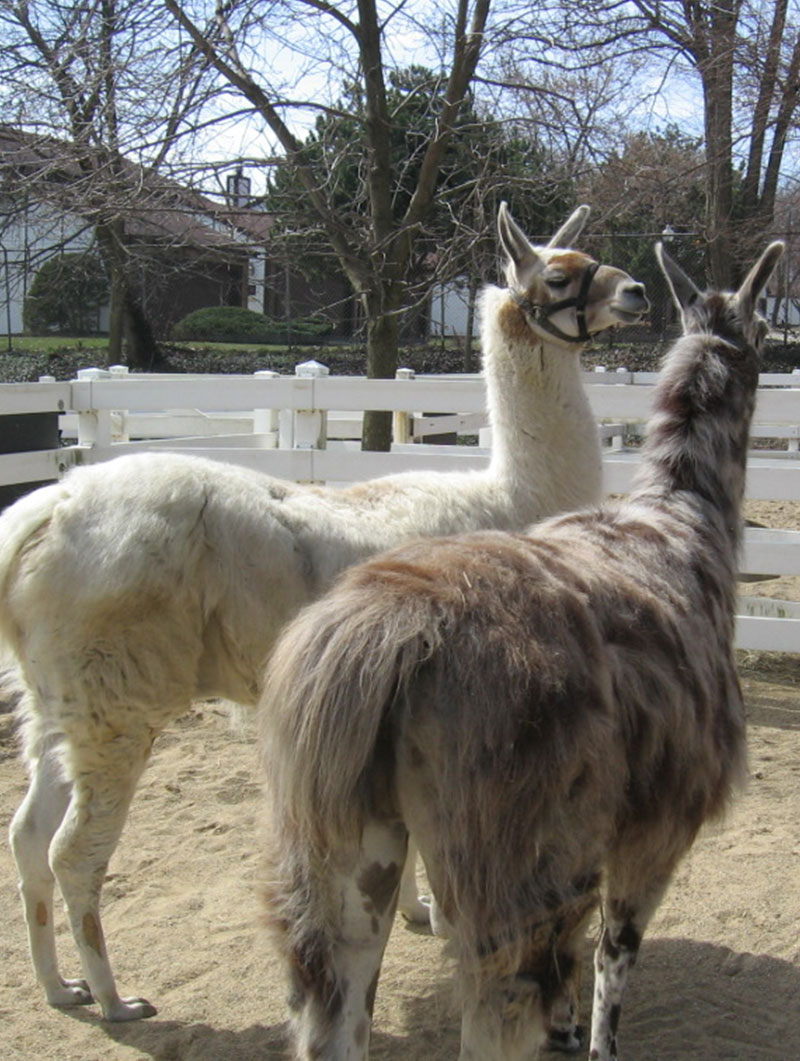Llama
Lama glama
Description:
The llama is a long-necked mammal with thick fur and a stubby tail. Its face resembles that of a camel, with a rounded muzzle and a split upper lip. A llama’s wool can come in a variety of colors including gray, beige, brown, and red, and can be patterned or a uniform color.
Size:
Llamas stand 3-4 feet (0.9-1.2 m) tall at the shoulders and 5-6 feet (1.5-1.8 m) tall at the head. Adults weigh between 250 and 450 pounds (113.4-204.1 kg). Females are generally smaller and weigh less than males.
Adaptations:
- Llamas’ feet have a unique structure. Each foot is made up of two large toes, which each have a toenail and pad. Because the bottoms of their feet are soft and sensitive, llamas are very sure-footed and cause less damage to the environment than a horse or mule would.
- The high concentration of hemoglobin in their blood helps llamas to survive in a high-altitude environment where there is little oxygen.
- The thick fur of llamas helps to protect them against animal bites.
- Llamas’ eyes, like those of many prey animals, are on the sides of their heads, enabling them to see in all directions.
- Llamas can escape predators by running at speeds of up to 40 mph.
- The ability to spit can help a llama to deter predators.
Diet:
Cosley Zoo’s llamas are fed hay and a commercial llama chow.
Reproduction:
A female llama can begin to breed when she is one year old. The gestation period is 350 days. She can have up to one baby (called a “cria”) per year until she is about 15 years old. Llamas can be bred at any time of the year. They are induced ovulators, which means they ovulate 24-36 hours after breeding. The cria weighs 18 to 33 pounds (8.2-15.0 kg) when it is born and can stand up within one hour. Crias are nursed by their mothers for six months before they are weaned.
Shelter and space needs:
The llamas at Cosley Zoo have an outside yard they inhabit during the day, where they get fresh air and exercise. They also have a stall in the barn which opens into another outdoor yard.
Life expectancy:
Llamas can live up to 20 years, with an average life expectancy of 15 years.
Relationship with man:
In the mountains of Peru, where they were domesticated, llamas have a variety of uses. As pack animals, llamas can carry 25-30% of their body weight. Llamas can also be a food source, providing their owners with meat and milk. Llama wool is used for weaving clothes and rope, the skin for leather, the fat for making candles, and the dried excrement for fuel. Llamas raised commercially in the United States today are raised for companion animals, shows, wool, and fertilizer. They also can serve as livestock guardians, protecting sheep, goats, and other animals from predators.
Fun Facts:
- The llama is one of the first domesticated animals. Llamas were domesticated in Peru approximately four thousand years ago. Their ancestors are wild guanacos.
- Llamas have many ways of communicating with each other. Their ear positions can give an indication of their mood. They also make a humming sound and, on rare occasions, they spit. Spitting is used to establish dominance and determine pecking order. Spitting at people is rare.
- Even though they do not have a hump, llamas are closely related to camels.






